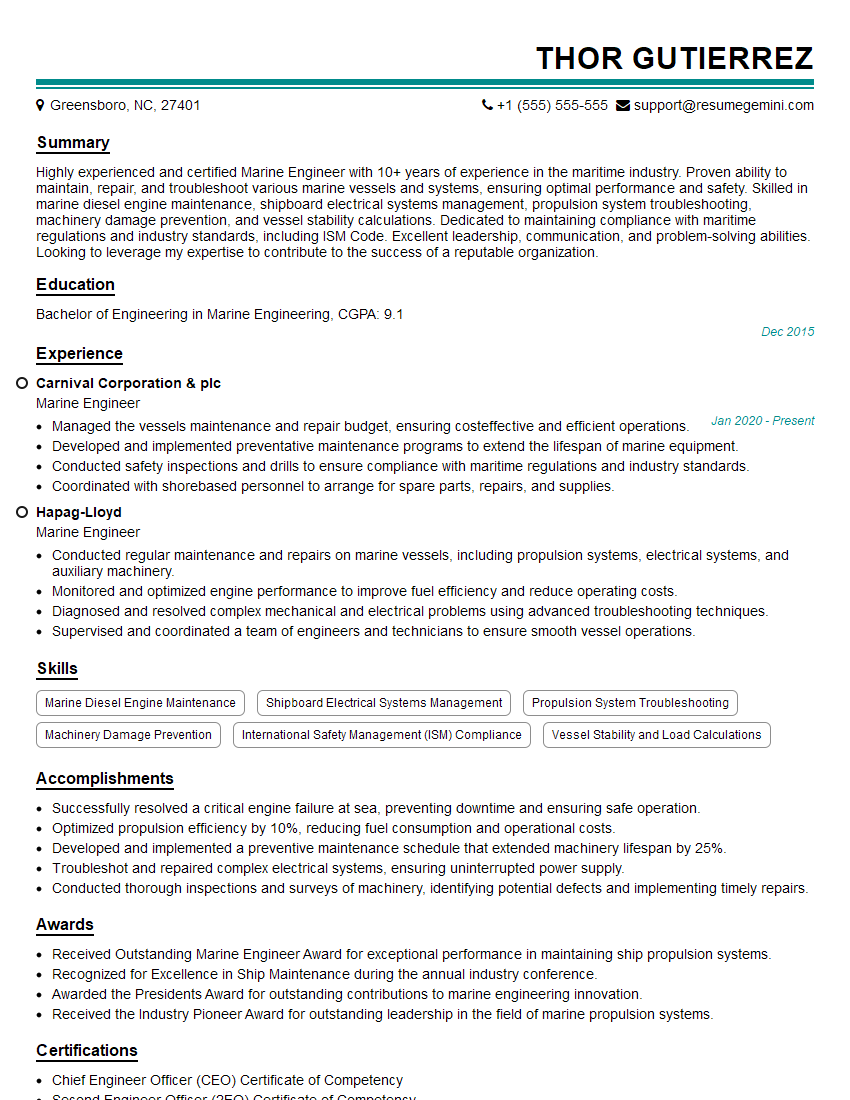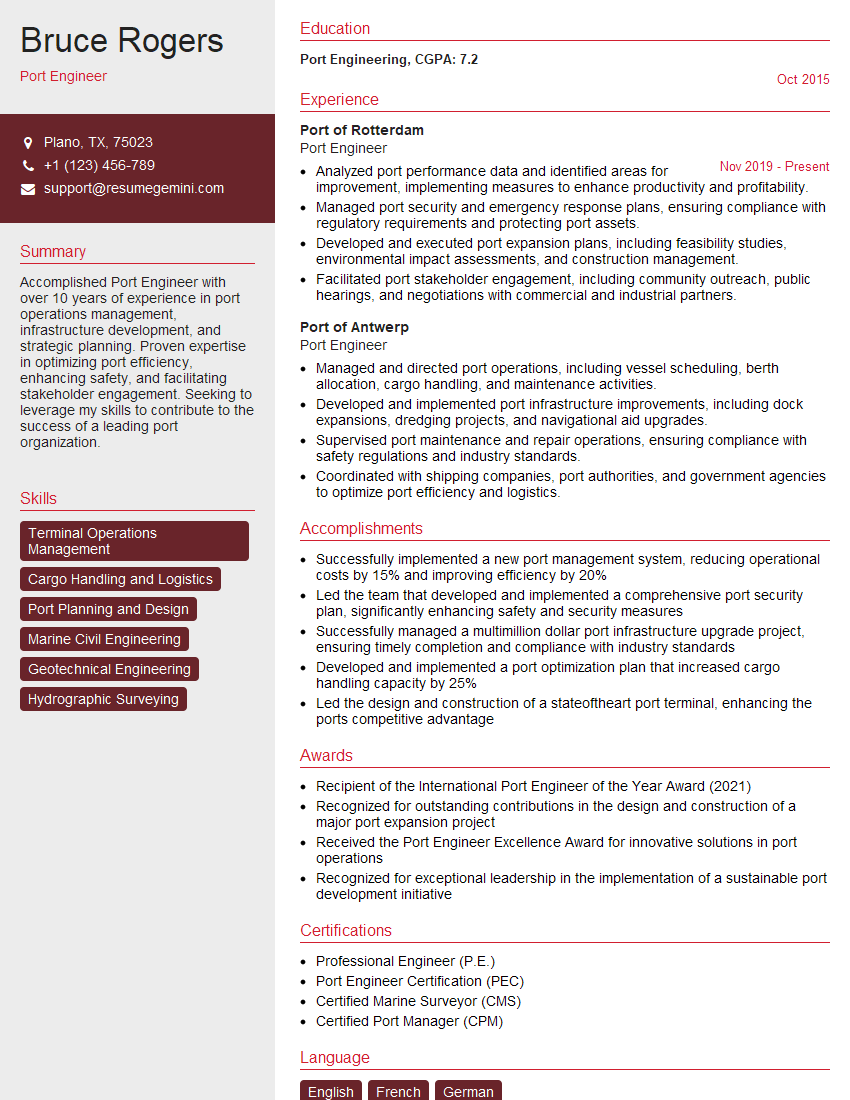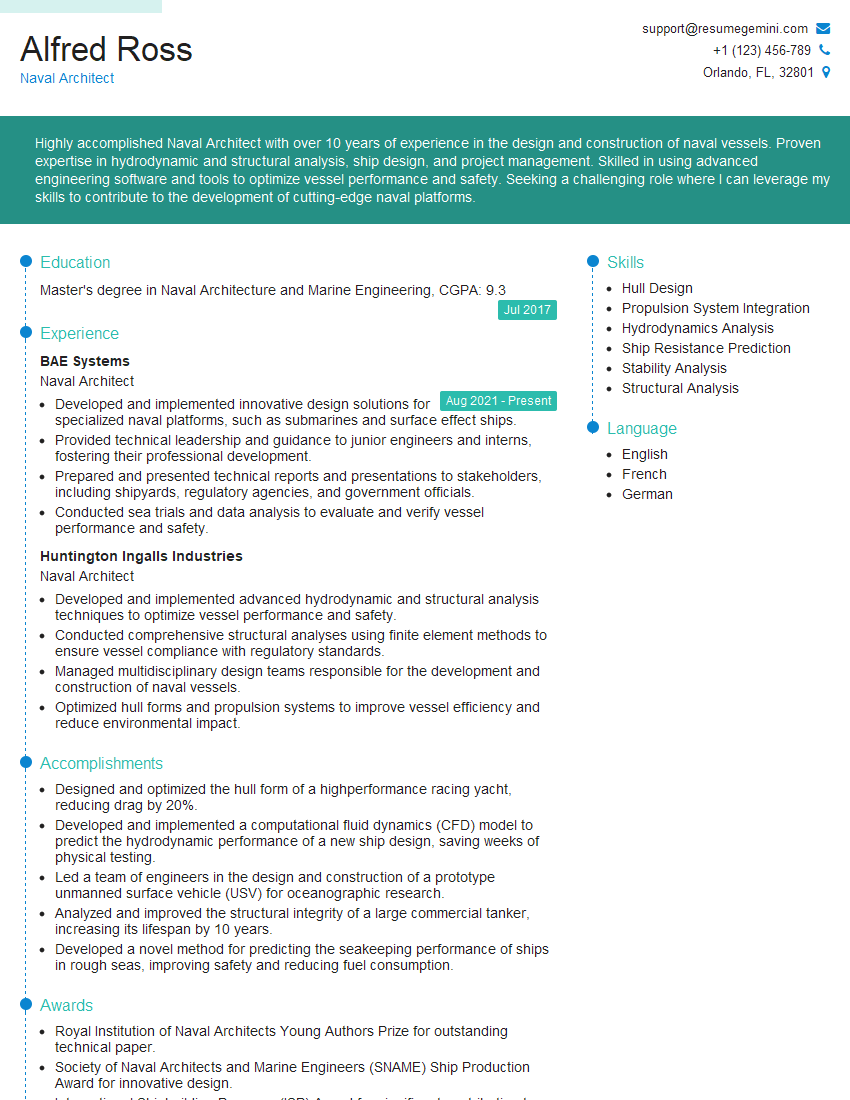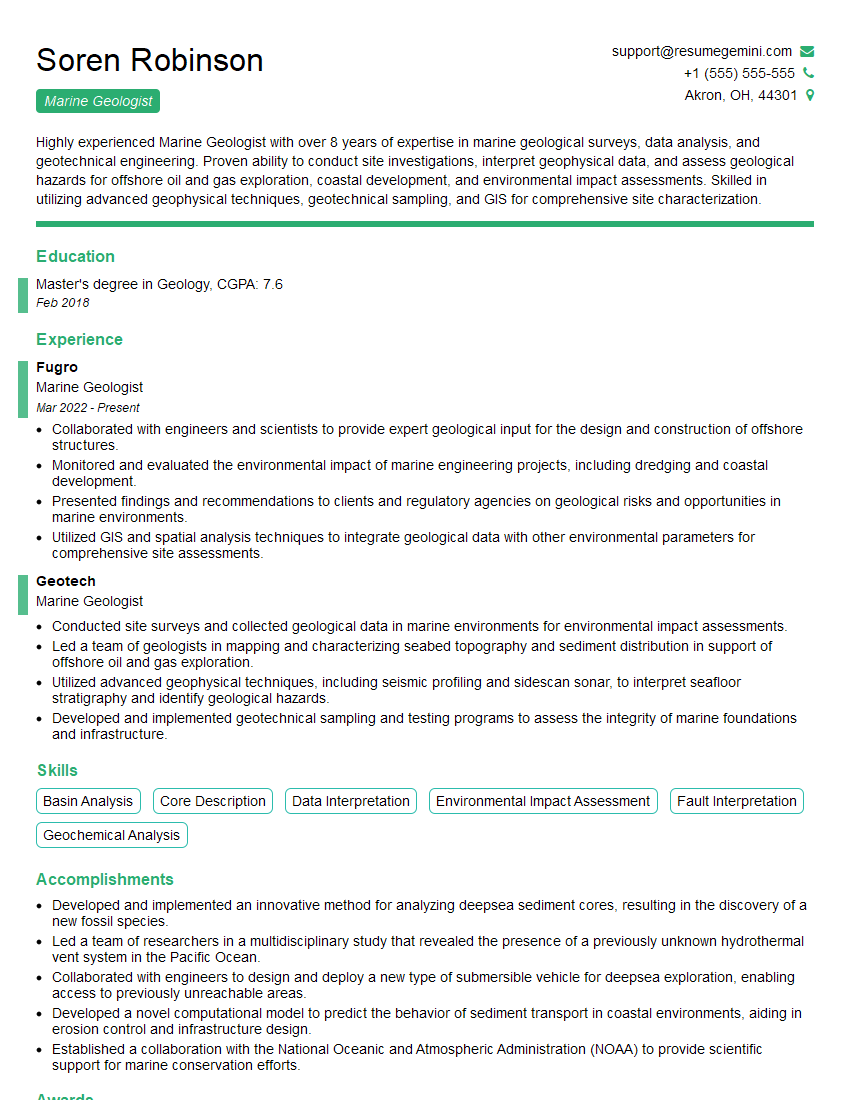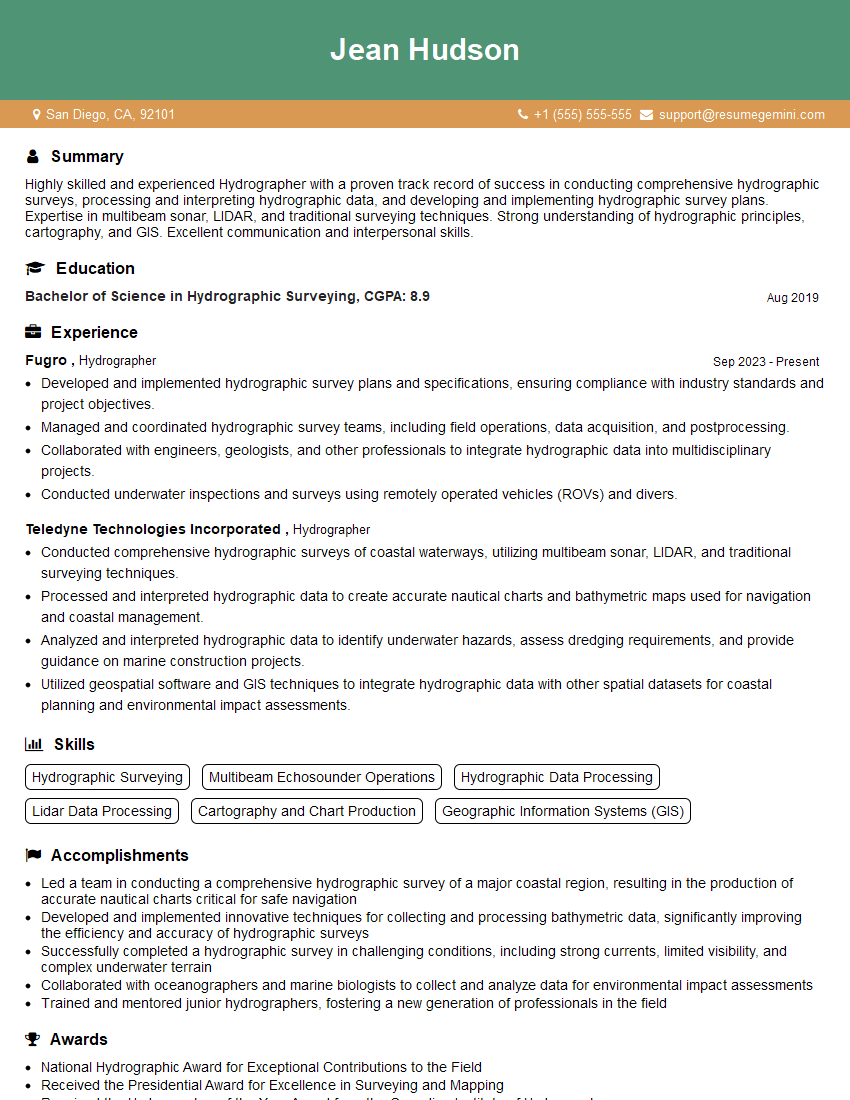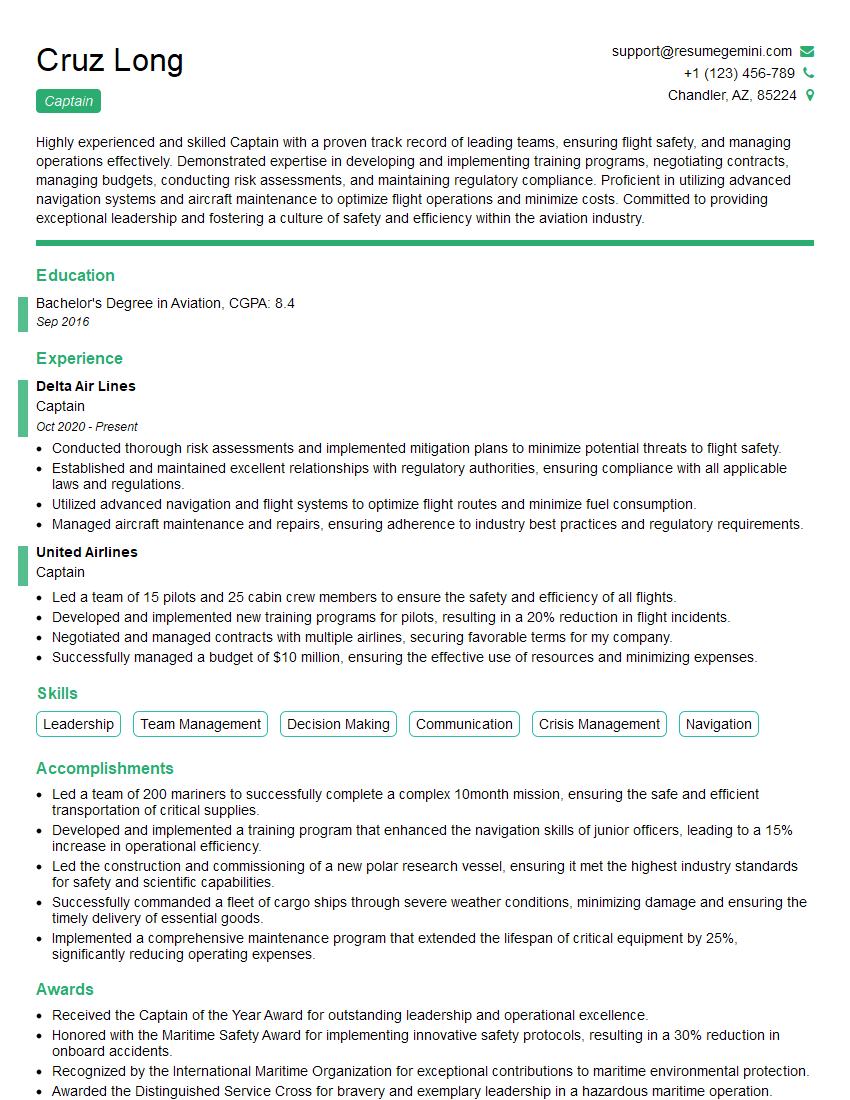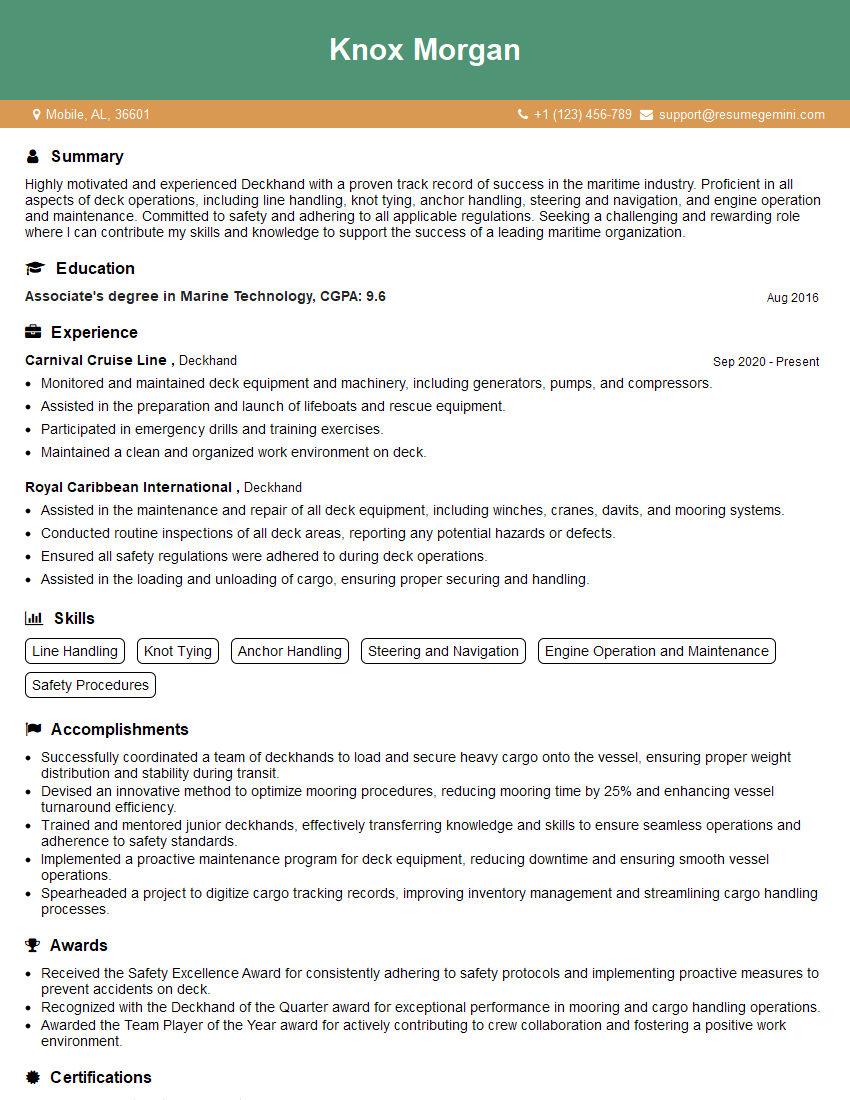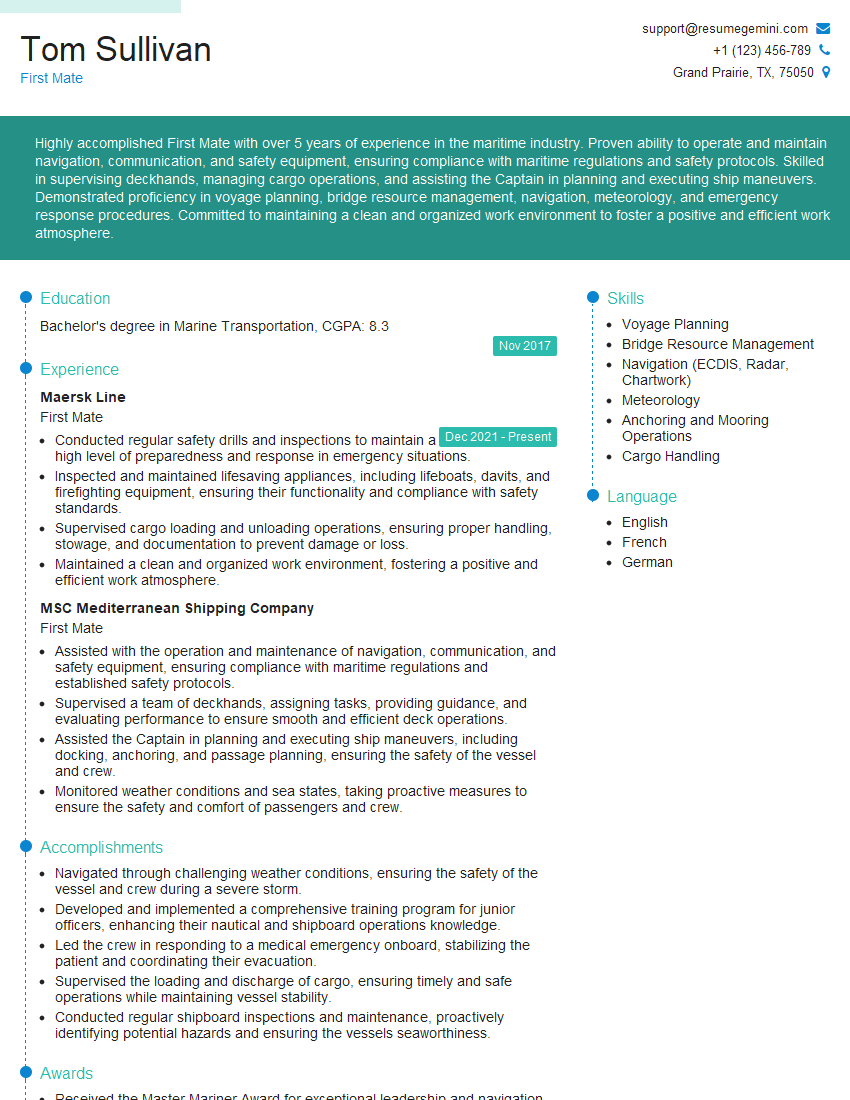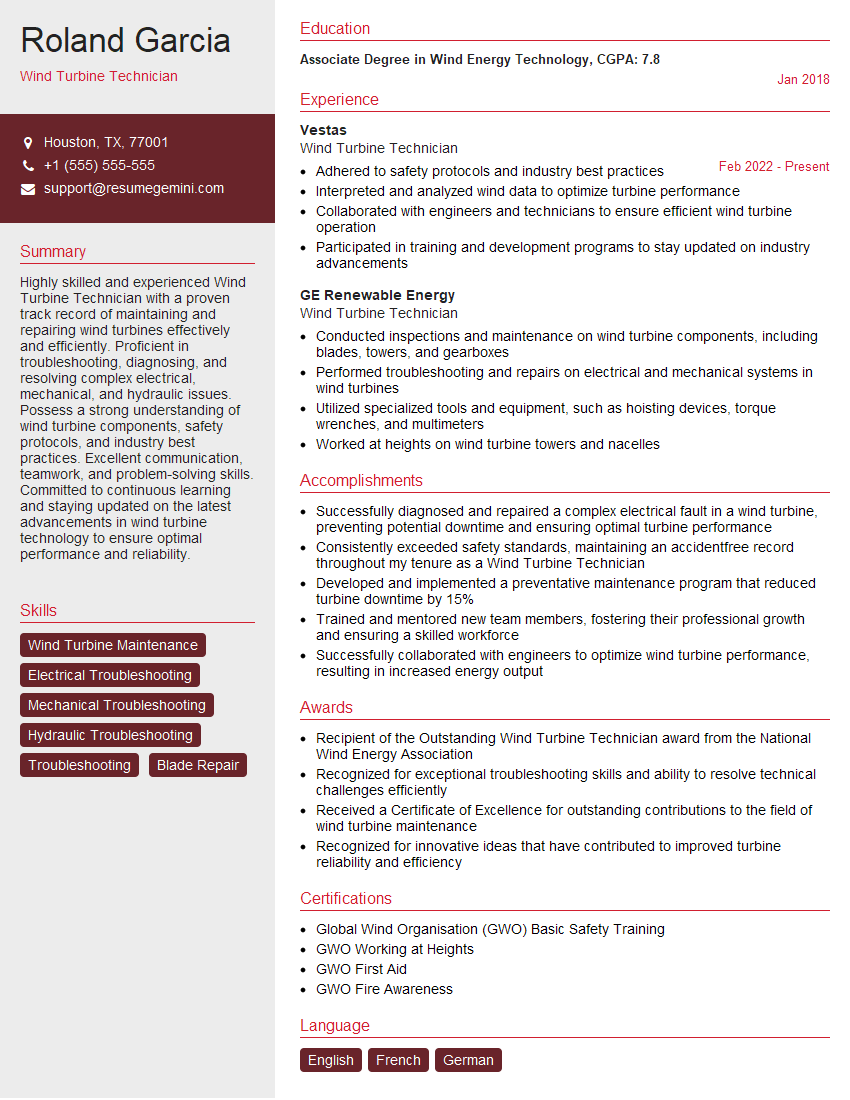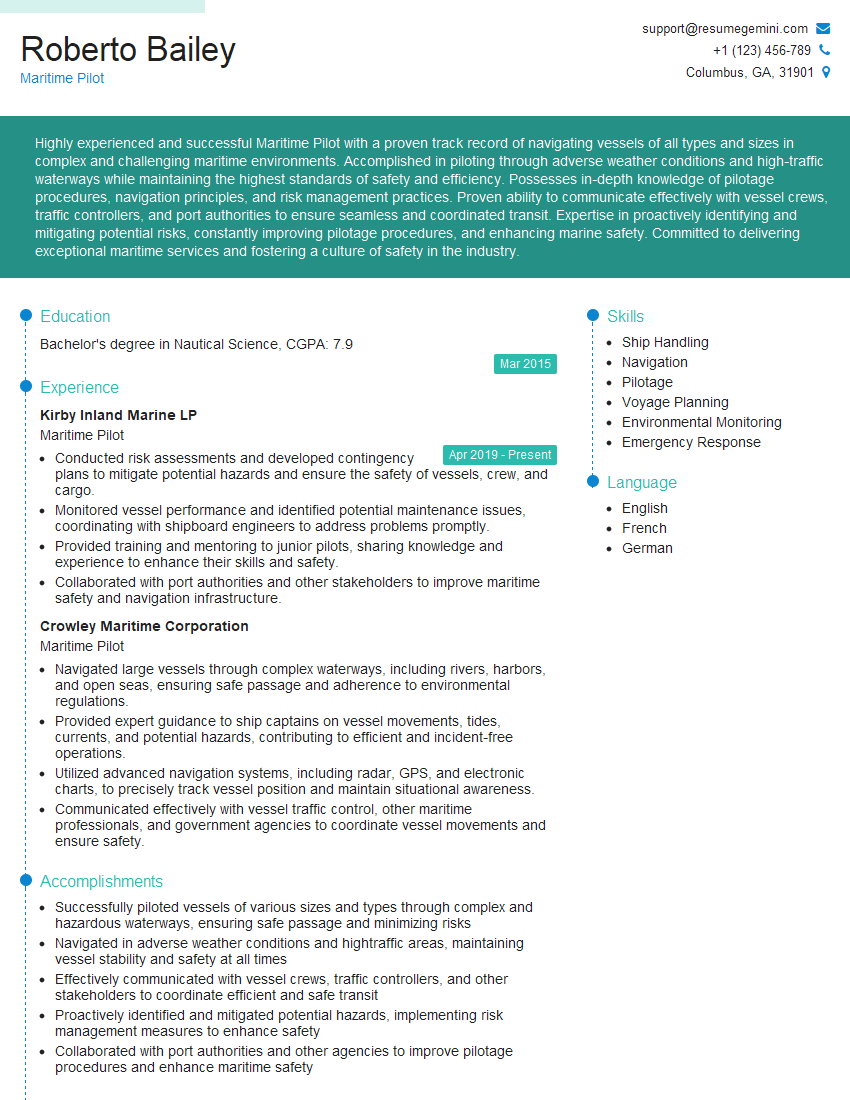The thought of an interview can be nerve-wracking, but the right preparation can make all the difference. Explore this comprehensive guide to Wind and Current Considerations interview questions and gain the confidence you need to showcase your abilities and secure the role.
Questions Asked in Wind and Current Considerations Interview
Q 1. Explain the Coriolis effect and its impact on ocean currents.
The Coriolis effect is an inertial force that appears to deflect moving objects (like air and water) to the right in the Northern Hemisphere and to the left in the Southern Hemisphere. It’s not a real force, but rather a consequence of Earth’s rotation. Imagine you’re on a spinning merry-go-round throwing a ball to a friend. The ball won’t go straight; it will curve because of the merry-go-round’s rotation. Similarly, the Earth’s rotation causes this apparent deflection.
This effect significantly influences ocean currents. Wind blowing across the ocean’s surface doesn’t just push the water directly; the Coriolis effect deflects the water, creating large-scale, rotating currents called gyres. These gyres are major features of the global ocean circulation, transporting heat and nutrients around the planet. For example, the Gulf Stream, a powerful warm current in the North Atlantic, is significantly shaped by the Coriolis effect. Without it, the current’s trajectory and strength would be drastically different.
Q 2. Describe different types of ocean waves and their generation mechanisms.
Ocean waves are disturbances that propagate through the water. Several types exist, each with its own generation mechanism:
- Wind Waves: These are the most common type, generated by wind blowing across the water’s surface. The stronger and longer the wind blows, the larger the waves become. Think of a gentle breeze creating ripples, escalating to powerful storm waves.
- Swell Waves: These are long-period, smooth waves that have traveled away from their generating area (often a storm). They’re characterized by their consistent, rolling motion and can travel vast distances across oceans.
- Tsunamis: These are devastating waves generated by underwater earthquakes, volcanic eruptions, or landslides. Unlike wind waves, they have incredibly long wavelengths and can travel at tremendous speeds across entire ocean basins.
- Seiches: These are standing waves that oscillate within an enclosed or partially enclosed body of water, like a lake or bay. They’re often caused by changes in atmospheric pressure or strong winds.
Q 3. How do wind patterns influence coastal erosion?
Wind patterns play a crucial role in coastal erosion. Strong, persistent winds can generate large waves that repeatedly crash against the coastline, eroding cliffs and beaches. The direction of the wind also matters; prevailing winds from a particular direction can lead to concentrated erosion along exposed coastlines. For example, consistently strong winds from the west might cause significant erosion on the western coast of a landmass. Furthermore, wind can transport sand and sediment, leading to both erosion (removal of material) and deposition (accumulation of material) in different areas along the coast. This process changes the shape of the coastline over time.
Q 4. What are the key factors affecting wind speed and direction near the coast?
Several factors affect wind speed and direction near the coast:
- Land-Sea Breeze Circulation: During the day, land heats up faster than the sea, creating a low-pressure area over land and a high-pressure area over the sea. This causes a sea breeze (wind blowing from sea to land). At night, the opposite occurs, resulting in a land breeze (wind blowing from land to sea).
- Large-Scale Weather Systems: Synoptic-scale weather systems (high and low-pressure systems, fronts) can significantly influence coastal winds. These systems often dictate the prevailing wind direction and speed over extended periods.
- Topography: Hills, mountains, and other landforms can channel or deflect wind, creating localized variations in wind speed and direction. Coastal valleys can experience funneling of winds, leading to increased wind speeds.
- Friction: Friction with the Earth’s surface slows down wind, particularly near the coast where land and water interact. This effect is more pronounced over land than over water.
Q 5. Explain the concept of Ekman transport.
Ekman transport describes the net movement of water in the ocean due to the combined effects of wind stress and the Coriolis effect. Imagine wind blowing across the ocean’s surface. The surface water is pushed by the wind, but the Coriolis effect deflects this movement to the right (in the Northern Hemisphere) or left (in the Southern Hemisphere). This deflected surface water then drags the water below it, creating a spiral pattern of water movement. The net transport of water, however, is not directly in the wind direction but at a roughly 90-degree angle to the wind (to the right in the Northern Hemisphere and to the left in the Southern Hemisphere).
This phenomenon is crucial for understanding ocean circulation patterns. Ekman transport creates upwelling (bringing nutrient-rich water from depth to the surface) and downwelling (pushing surface water downwards), significantly impacting marine ecosystems and nutrient cycles.
Q 6. Describe the different types of ocean currents (e.g., surface currents, deep currents).
Ocean currents are large-scale movements of water within the ocean. They are categorized in several ways:
- Surface Currents: Driven primarily by wind, these currents are found in the upper few hundred meters of the ocean. The Coriolis effect and continental boundaries strongly influence their paths, creating gyres and other large-scale circulation patterns.
- Deep Currents: These currents are driven by density differences in the water, caused by variations in temperature and salinity. Cold, salty water is denser and sinks, creating deep currents that move slowly but transport vast amounts of water around the globe. A prime example is the thermohaline circulation, sometimes called the “global conveyor belt,” which plays a vital role in regulating global climate.
- Tidal Currents: These currents are caused by the gravitational pull of the moon and sun, leading to periodic changes in sea level that cause water to flow in and out of coastal areas.
Q 7. How do you model wind and current interactions in a numerical simulation?
Modeling wind and current interactions in numerical simulations involves using sophisticated computer models that solve complex equations governing fluid motion. These models typically use techniques such as:
- Navier-Stokes Equations: These equations describe the motion of fluids, including the effects of pressure, viscosity, and external forces like wind stress.
- Grid-Based Methods: The ocean and atmosphere are discretized into a grid, and the equations are solved at each grid point. Common methods include finite difference, finite volume, and finite element methods.
- Coupling of Atmospheric and Oceanic Models: Accurate simulations require coupling atmospheric models (that predict wind fields) with oceanic models (that predict current fields). This involves exchanging information between the models at regular intervals.
- Parameterizations: Because resolving all scales of motion is computationally infeasible, certain small-scale processes (like wave breaking) are often parameterized—represented using simplified mathematical formulations.
The specifics of the modeling approach depend on the spatial and temporal scales of interest and the available computational resources. For example, simulating global ocean circulation requires a coarser grid resolution than simulating coastal processes, which demand higher resolution to capture the complex interactions between wind, waves, and currents near the coast. Example code (pseudo-code):for each grid cell: calculate wind stress solve Navier-Stokes equations for water motion update current velocitiesend for
Q 8. What are the challenges of designing structures resistant to wind and wave loading?
Designing structures resistant to wind and wave loading presents significant challenges because these forces are highly variable and unpredictable. The primary difficulty lies in accurately predicting the magnitude and direction of these loads over the structure’s lifespan. This involves considering several factors simultaneously:
- Dynamic Forces: Wind and waves are not static; they fluctuate in intensity and direction, creating complex dynamic forces that require sophisticated engineering models to analyze.
- Fatigue: Repeated cyclical loading from wind and waves can lead to material fatigue and eventual failure, even if the maximum load is well below the ultimate strength of the material. This requires considering the entire load history of the structure.
- Resonance: If the natural frequency of the structure matches the frequency of the wind or wave loading, resonance can occur, leading to catastrophic amplification of the forces. Careful design is essential to avoid resonance.
- Environmental Variability: Wind speeds and wave heights vary significantly with location, time of year, and even short-term weather events. Designing for the worst-case scenario is often impractical and uneconomical, requiring statistical analysis and risk assessment.
- Material Selection: Choosing materials that are resistant to corrosion from saltwater and capable of withstanding the cyclic loading is crucial. Often, specialized materials or protective coatings are required.
For example, designing an offshore wind turbine requires careful consideration of the turbine’s response to extreme wind gusts and wave impacts. The tower must be strong enough to withstand bending moments, and the foundation must be robust enough to anchor the entire structure firmly in the seabed, preventing overturning or uplift.
Q 9. Explain the importance of wind and current data in offshore construction projects.
Wind and current data are absolutely critical in offshore construction projects, impacting safety, cost, and the overall success of the operation. Accurate data informs crucial decisions throughout the project lifecycle:
- Site Selection: Identifying locations with favorable wind and current conditions is crucial for optimizing energy production (for wind farms) or minimizing structural loads (for any offshore structure).
- Structural Design: The magnitude and frequency of wind and currents directly influence the design parameters for all offshore structures, such as foundations, platforms, and moorings. Insufficient data can lead to under-designed structures, putting them at risk of failure.
- Construction Planning: Knowing the expected wind and current conditions during the construction phase helps determine safe operational windows, optimizing construction schedules and reducing risk.
- Vessel Operations: Accurate forecasts are essential for the safe and efficient operation of vessels involved in construction and maintenance. Strong winds and currents can significantly impact vessel stability and maneuverability.
- Risk Assessment: Understanding the probability of extreme wind and current events allows for a realistic risk assessment and the implementation of appropriate mitigation strategies. This can involve designing for higher loads, using advanced mooring systems, or scheduling work around predicted storms.
Imagine constructing a large offshore wind turbine without accurate wind data. Underestimating the wind loads could lead to structural failure, causing significant financial loss and potential environmental damage.
Q 10. How do you interpret wind and current data from various sources (e.g., buoys, satellites)?
Interpreting wind and current data requires a thorough understanding of the limitations and capabilities of different data sources. Each source provides specific types of information with varying degrees of accuracy and resolution.
- Buoys: Oceanographic buoys provide highly localized, real-time measurements of wave height, period, direction, and current speed and direction. They offer accurate data for a limited spatial area but are more prone to damage or malfunction. Data should be checked for quality and consistency.
- Satellites: Satellites provide broad spatial coverage, giving a large-scale view of wind fields and ocean currents. However, satellite data generally has lower spatial and temporal resolution than buoys, and atmospheric conditions can affect data accuracy. Data often needs processing and interpolation to meet project needs.
- Numerical Weather Prediction (NWP) Models: These models simulate atmospheric and oceanic processes to predict wind and current conditions. NWP models provide forecasts but their accuracy decreases with time horizon and depends heavily on input data quality. Comparing model outputs from multiple sources increases reliability.
- Historical Data: Analyzing historical meteorological and oceanographic records provides valuable information on long-term patterns and extremes, used in statistical analyses to define design criteria.
For example, to design a floating offshore wind turbine, I would combine satellite imagery of ocean surface currents with buoy data for detailed wave measurements at the potential site location. I’d also consult NWP models for predictions of wind speed and direction, considering the uncertainties inherent in each data source. Combining these datasets allows for more robust and reliable design decisions.
Q 11. Describe the impact of climate change on wind and ocean currents.
Climate change significantly impacts wind and ocean currents. The effects are complex and vary regionally, but some key impacts include:
- Increased Wind Speeds: Some regions are experiencing stronger and more frequent high-wind events, altering the design requirements for wind turbines and other structures.
- Changes in Wind Patterns: Shifts in atmospheric circulation patterns can lead to altered wind regimes, requiring re-evaluation of resource assessments for offshore wind energy.
- Sea Level Rise: Rising sea levels increase the likelihood of coastal flooding and erosion, impacting the stability and lifespan of coastal and offshore structures.
- Ocean Current Changes: Warming ocean temperatures and melting glaciers are modifying ocean currents, affecting marine ecosystems and influencing the design requirements for structures that interact with currents.
- Increased Storm Intensity: Climate models predict an increase in the frequency and intensity of storms, resulting in larger and more frequent wave events that necessitate the design of more robust structures.
For example, the increased frequency of hurricanes in the Atlantic Ocean necessitates designs for offshore structures that can withstand more intense wave action than those built in previous decades. This includes stricter design codes and more robust foundation systems.
Q 12. Explain the design considerations for floating offshore wind turbines.
Designing floating offshore wind turbines (FOWTs) presents unique challenges due to the dynamic nature of the ocean environment. Key design considerations include:
- Mooring System: A robust and reliable mooring system is crucial to maintain the turbine’s position and stability in varying wind and wave conditions. This involves choosing appropriate mooring lines (e.g., chains, synthetic ropes), anchors, and tensioning mechanisms. The system must withstand extreme loads and maintain its integrity over the turbine’s lifespan.
- Platform Stability: The floating platform must be designed to minimize motion and maintain its structural integrity under significant wave loads and wind gusts. This involves optimizing the platform’s shape, size, and weight distribution to ensure stability.
- Dynamic Interactions: The interaction between the turbine, platform, and mooring system under various loading conditions needs to be carefully modeled and analyzed to ensure structural integrity and efficient energy capture. This requires sophisticated computer simulations.
- Environmental Considerations: The design should minimize the environmental impact of the FOWT, considering potential effects on marine ecosystems and the mitigation of risks related to anchoring and cable deployment.
- Survivability: The structure must be designed to survive extreme weather events without suffering significant damage or failure. This requires considering not only the ultimate strength of the components but also their fatigue resistance.
A common approach involves using tension-leg platforms or spar buoys for the floating structure. The choice of platform type depends on water depth, wind and wave conditions, and project-specific requirements. The mooring system is often optimized using sophisticated numerical modeling to achieve stability and minimize dynamic loads.
Q 13. How do you assess the risk of extreme wind and wave events?
Assessing the risk of extreme wind and wave events involves a combination of statistical analysis and numerical modeling. The goal is to determine the probability of exceeding specific thresholds for wind speed and wave height over the design life of a structure.
- Statistical Analysis: This involves analyzing long-term historical data (e.g., from buoys, weather stations) to determine the frequency and intensity of past extreme events. Statistical distributions (e.g., Weibull, Gumbel) are used to extrapolate this data to estimate the probability of future events exceeding a given threshold.
- Numerical Modeling: NWP models and wave models are used to simulate potential extreme wind and wave scenarios. These models can simulate storms and their impacts on the coastal area, allowing for detailed assessment of the resulting forces.
- Return Periods: The concept of return periods is critical. A 50-year return period, for example, means a specific wind speed or wave height is expected to be exceeded once every 50 years, on average. The structure must be designed to withstand loads exceeding this threshold.
- Risk Matrices: Combining the likelihood of an extreme event with the potential consequences of failure allows creating risk matrices, visually summarizing the risks associated with different design decisions.
For example, to assess the risk for an offshore platform, we might use historical wave data to determine the 100-year return period wave height. We’d then use numerical modeling to simulate the platform’s response to a wave of that height, evaluating potential structural damage. This information helps determine design requirements to ensure an acceptable level of risk.
Q 14. Describe methods for predicting wind and current conditions for a specific location.
Predicting wind and current conditions for a specific location requires a combination of techniques, leveraging multiple data sources:
- Numerical Weather Prediction (NWP) Models: These sophisticated computer models simulate atmospheric and oceanic processes to forecast wind speed, direction, and wave parameters. The accuracy of these predictions varies depending on the model’s resolution, the quality of input data, and the forecast horizon.
- Wave Models: These models simulate the generation, propagation, and dissipation of ocean waves. They are crucial for predicting wave heights, periods, and directions, considering factors like wind speed, fetch (the distance over which wind blows), and water depth.
- Current Models: These models predict ocean currents based on factors such as wind stress, temperature gradients, and the Earth’s rotation. These models are useful for assessing the potential impact of currents on floating structures.
- Ensemble Forecasting: Running multiple NWP and wave models and combining their results reduces uncertainty and provides a more reliable forecast. This approach helps to account for the inherent uncertainties in the models.
- Data Assimilation: This technique incorporates real-time observational data (e.g., from buoys, satellites) into the models to improve their accuracy and reduce uncertainties. This increases the reliability of short-term predictions.
For example, predicting wind and wave conditions for an offshore wind farm would involve using a high-resolution NWP model coupled with a wave model to simulate wave propagation. The results would be verified against real-time data from local buoys. Ensemble forecasting techniques could then be used to generate a probabilistic forecast, providing a range of possible scenarios.
Q 15. What are the environmental impacts of offshore wind farms?
Offshore wind farms, while crucial for renewable energy, do have environmental impacts. These impacts are complex and vary depending on location and design. Key concerns include:
- Habitat disruption and loss: Construction activities can disturb seabed habitats, affecting benthic organisms and potentially leading to sediment plumes that smother sensitive marine life. The physical presence of the turbines can also alter water flow patterns and impact fish migration routes.
- Noise and vibration: Construction and operation generate underwater noise that can negatively affect marine mammals, such as whales and dolphins, potentially impacting their communication, navigation, and foraging behavior.
- Bird and bat mortality: Although mitigation measures exist, collisions with turbine blades remain a risk for birds and bats, particularly during migration periods. This necessitates careful site selection and operational strategies.
- Electromagnetic fields: The presence of electrical infrastructure could potentially affect the behavior of some marine animals, though research on this aspect is still ongoing.
- Visual impact: Turbines can alter the visual landscape, potentially affecting tourism and recreational activities in the surrounding area. However, this impact tends to be more localized than other concerns.
Mitigation strategies such as careful site selection, employing noise-reducing construction techniques, and implementing bird and bat monitoring programs are crucial to minimizing these environmental impacts. Environmental Impact Assessments (EIAs) are critical before any offshore wind farm project commences, ensuring a holistic consideration of ecological factors.
Career Expert Tips:
- Ace those interviews! Prepare effectively by reviewing the Top 50 Most Common Interview Questions on ResumeGemini.
- Navigate your job search with confidence! Explore a wide range of Career Tips on ResumeGemini. Learn about common challenges and recommendations to overcome them.
- Craft the perfect resume! Master the Art of Resume Writing with ResumeGemini’s guide. Showcase your unique qualifications and achievements effectively.
- Don’t miss out on holiday savings! Build your dream resume with ResumeGemini’s ATS optimized templates.
Q 16. Explain different techniques for measuring ocean currents.
Measuring ocean currents involves several techniques, each with its strengths and limitations. These can be broadly categorized as:
- Direct measurement: This involves deploying instruments directly into the water column. Examples include:
- Current meters: These devices, often propeller-based or employing acoustic Doppler current profilers (ADCPs), directly measure the speed and direction of water movement at various depths. ADCPs are particularly useful as they can provide profiles of current velocity over a substantial water depth.
- Lagrangian drifters: These are free-floating instruments that drift with the current, providing data on the trajectories and speeds of currents over time. They’re particularly useful for studying large-scale circulation patterns.
- Indirect measurement: These techniques infer current patterns from other observable phenomena.
- Satellite altimetry: Satellites equipped with radar altimeters measure the height of the sea surface. Variations in sea surface height can be used to infer geostrophic currents (currents driven by pressure gradients).
- Acoustic tomography: Sound waves are transmitted across a region of ocean and their travel time measured. Variations in travel time reflect changes in water temperature and salinity, which in turn influence current speeds.
- Remote sensing: Techniques such as satellite imagery and aerial photography can be used to observe surface currents, particularly in coastal areas.
The choice of technique depends on the specific application, spatial and temporal scales of interest, and budget constraints. For example, ADCPs are ideal for detailed, localized studies, while satellite altimetry is better suited for studying large-scale ocean currents.
Q 17. Discuss the influence of tides on coastal currents.
Tides exert a significant influence on coastal currents, creating complex patterns of flow. The primary mechanism is the gravitational pull of the moon and sun, causing rhythmic rise and fall of sea level. This tidal forcing generates:
- Tidal currents: These are horizontal water movements caused by the rising and falling tide. They are often strong near constrictions, such as inlets and channels, where the tidal wave is squeezed and accelerated. Think of a river flowing both ways depending on the tide!
- Tidal mixing: The vertical movement of water associated with tides can mix the water column, influencing the distribution of nutrients, temperature, and salinity. This is particularly important in estuaries where freshwater and saltwater meet.
- Residual currents: These are the net currents remaining after the tidal fluctuations are averaged out. They can be driven by other factors like wind, river discharge, and density differences, but the tides significantly modify their patterns.
Understanding the interaction between tides and coastal currents is vital for many applications, including coastal engineering, navigation, and environmental management. For instance, designing harbors or predicting the spread of pollutants requires careful consideration of both tidal currents and other driving forces.
Q 18. How do you assess the impact of wind and current on marine vessel operations?
Assessing the impact of wind and current on marine vessel operations is critical for safety and efficiency. This involves considering several factors:
- Vessel type and characteristics: Different vessels respond differently to wind and currents. A large tanker will behave differently than a small fishing boat.
- Environmental conditions: Real-time data on wind speed and direction, current speed and direction, and wave height are crucial. This information is often obtained from meteorological and oceanographic forecasts and observations.
- Navigation and route planning: Optimal routes must be planned, taking into account the predicted wind and currents to minimize fuel consumption and travel time while ensuring safe operation.
- Maneuvering and control: The captain must account for wind and currents when maneuvering the vessel, especially during docking or passing near other ships or structures.
- Mooring and anchoring: Wind and currents significantly impact the forces on mooring lines and anchors, necessitating proper design and equipment selection.
Sophisticated software and models are used to predict the combined effects of wind and currents, enabling better decision-making regarding vessel operations. Ignoring these factors can lead to delays, increased fuel consumption, and potential accidents.
Q 19. What software or tools are you familiar with for analyzing wind and current data?
I am familiar with a range of software and tools for analyzing wind and current data. These include:
- Specialized hydrodynamic models: Software packages like Delft3D, MIKE 21, and ROMS are used to simulate hydrodynamic processes, including currents and waves, often coupled with atmospheric models to incorporate wind data.
- Geographical Information Systems (GIS): Software such as ArcGIS and QGIS are used to visualize and analyze spatial data, including wind and current measurements, enabling spatial patterns and trends to be readily identified.
- Statistical software: Packages like R and MATLAB provide powerful tools for statistical analysis of wind and current data, helping to identify correlations, trends, and uncertainties.
- Specialized data visualization tools: Software tailored for visualizing oceanographic and meteorological data allows for better understanding of complex patterns and trends, facilitating efficient data interpretation.
The specific choice of software depends on the complexity of the analysis, the type of data available, and the research questions being addressed. Often, multiple software packages are used in combination.
Q 20. Describe your experience with data acquisition and processing of wind and current data.
My experience with wind and current data acquisition and processing spans several years and diverse projects. I have been involved in:
- Deploying and retrieving oceanographic instruments: This includes deploying and recovering ADCPs, current meters, and wave buoys, ensuring proper calibration and data quality control. I’m familiar with both manual and automated data acquisition techniques.
- Data quality control and processing: This involves identifying and correcting errors in the raw data, using various techniques to address gaps and inconsistencies in measurements. I’m proficient in using signal processing techniques to filter and clean noisy data.
- Data analysis and interpretation: I use statistical methods and hydrodynamic models to analyze the data, identifying key trends, patterns, and correlations. I’m adept at translating complex datasets into meaningful interpretations for various stakeholders.
- Data visualization and reporting: I create clear and informative visualizations, maps, and reports to communicate findings effectively to both technical and non-technical audiences. My experience encompasses creating reports for both scientific publications and regulatory compliance.
For instance, in one project, we utilized ADCP data and hydrodynamic modeling to assess the impact of a proposed offshore wind farm on local currents. This involved data acquisition, quality control, model calibration, and sensitivity analysis. The results were incorporated into the project’s Environmental Impact Assessment.
Q 21. How do you account for wind and currents in the design of marine pipelines?
Accounting for wind and currents is critical in the design of marine pipelines to ensure their structural integrity and operational safety. This is achieved through a combination of:
- Hydrodynamic analysis: Sophisticated computer models are employed to simulate the interaction between the pipeline, currents, and waves. These models consider factors such as pipeline geometry, material properties, and environmental conditions.
- Environmental data: Detailed wind and current data, gathered from various sources, including measurements and forecasts, are essential inputs to the hydrodynamic models. This information helps characterize the environmental loading on the pipeline.
- Structural analysis: The results of the hydrodynamic analysis are used to determine the forces and stresses acting on the pipeline. This information is then used to design the pipeline with appropriate wall thickness and support structures (e.g., anchors, spans, and buoyancy).
- Pipeline laying strategies: The pipeline’s route and laying method are chosen to minimize exposure to harsh environmental conditions. Considerations may include avoiding areas with strong currents, employing specialized vessels and techniques to lay the pipeline accurately and safely.
- Monitoring and maintenance: After installation, the pipeline is regularly monitored to assess its condition and integrity. Any changes in environmental conditions or potential damage requires prompt attention.
For example, in deep-water pipeline projects, the hydrodynamic loads due to currents and waves can be significant, demanding robust design features to ensure long-term structural stability and resistance against fatigue failure. Careful consideration of these forces is crucial to prevent costly failures and environmental damage.
Q 22. Explain the significance of wind and current profiles in mooring design.
Understanding wind and current profiles is absolutely critical in mooring design. Mooring systems, whether for offshore platforms, floating wind turbines, or even ships, need to withstand the forces exerted by these environmental factors. The design process isn’t just about average conditions; we need to consider the full range of possibilities.
Wind profiles describe how wind speed and direction vary with height above the water surface. A higher wind speed at greater heights means more force on taller structures. We use this data to calculate the tension on mooring lines and ensure the structure can handle the maximum expected load. For example, a tall floating wind turbine will experience much higher wind forces at its hub height compared to its base, dictating the design of its mooring system.
Current profiles show how water velocity varies with depth. Stronger currents at certain depths might put more stress on specific parts of the mooring system, particularly if the mooring lines are at varying depths. This needs careful consideration to ensure sufficient slack and avoid excessive tension in any single line. Imagine a deep-water mooring system; a strong subsurface current could significantly impact the system’s stability more than surface currents.
Ignoring these profiles could lead to mooring failures, resulting in significant financial losses, environmental damage, and potential safety risks.
Q 23. Describe the role of wind and currents in sediment transport.
Wind and currents play a dominant role in sediment transport, shaping coastlines and impacting marine ecosystems. Think of it like a river of sand under the sea.
Wind, primarily through its effect on waves, generates energy that stirs up sediment on the seabed. Stronger winds lead to larger waves, which increase the erosive power of the water and resuspend sediment particles.
Currents act as the primary transport mechanism. Once sediment is suspended, currents carry it along, the strength and direction of the current determining how far and where the sediment is deposited. This is why we see sandbars and deltas forming in specific locations – they’re zones where currents slow down and deposit their sediment load.
The interaction between wind and currents is complex. For example, a strong current flowing against a prevailing wind can generate significant wave action, enhancing sediment resuspension and transport. Understanding this interaction is crucial in coastal engineering projects, predicting coastal erosion, and managing dredging operations. The grain size of the sediment also plays a vital role: finer sediments are more easily moved than coarser ones.
Q 24. How do you handle uncertainties in wind and current forecasting?
Uncertainties in wind and current forecasting are inherent; it’s not an exact science. We address this using a combination of techniques:
- Probabilistic forecasting: Instead of single-point predictions, we use models that provide a range of possible outcomes with associated probabilities. This allows us to design for a range of scenarios, not just the most likely one.
- Sensitivity analysis: We assess how changes in wind and current parameters affect the design. This helps identify the most critical parameters and prioritize the accuracy of their prediction.
- Safety factors: We incorporate safety factors into the design to account for the uncertainties. These factors increase the capacity of the structure beyond the predicted loads.
- Real-time monitoring: For critical projects, real-time data from buoys, weather stations, and other sensors are used to adjust operations and provide early warning of potential problems.
For instance, when designing a mooring system for an offshore oil platform, we might use a probabilistic model to determine the likely maximum tension on the mooring lines, allowing us to design for a scenario with a 99% probability of not being exceeded.
Q 25. What are the limitations of various wind and current measurement techniques?
Various techniques exist for measuring wind and currents, each with its own limitations:
- Anemometers (wind): These are relatively simple and reliable for measuring wind speed and direction at a point. However, they don’t provide spatial information about the wind profile, and their accuracy can be affected by their location and surrounding obstructions.
- Current meters (current): These come in many varieties (acoustic Doppler current profilers, electromagnetic current meters, etc.). ADCPs offer excellent spatial resolution, but their accuracy can be influenced by factors like suspended sediment concentration or air bubbles. Electromagnetic current meters have good accuracy but often only measure current velocity at a single point.
- Remote sensing (wind and current): Satellites and radar can provide data over large areas, but their resolution is lower than point measurements, and they can be affected by weather conditions.
For example, an ADCP may struggle to provide accurate readings in highly turbid waters, whereas an electromagnetic current meter would offer a more stable measurement but at a single point only. The best approach is often to combine multiple techniques to gain a comprehensive understanding of wind and current conditions.
Q 26. Explain the concept of wave attenuation due to water depth.
Wave attenuation refers to the reduction in wave height and energy as waves propagate through shallower water. Imagine throwing a pebble into a deep pool versus a shallow puddle. The waves in the puddle are smaller and dissipate more quickly.
As water depth decreases, the wave interacts more strongly with the seabed. This interaction causes energy to be transferred to the seabed and dissipated as friction, reducing the wave height and ultimately leading to wave breaking in very shallow waters. The process is governed by the relationship between the water depth and the wave’s wavelength. In deeper water, the wave’s energy is largely unaffected by the seabed, but as it moves into shallower water, the wave ‘feels’ the bottom, resulting in energy loss.
This is crucial for coastal engineering projects. Understanding wave attenuation allows us to predict wave impact on coastal structures, such as seawalls and breakwaters. For instance, we’d expect a lesser impact from waves in a sheltered bay with shallow water compared to a more exposed location with deeper water.
Q 27. Describe your experience working with different types of current meters.
My experience encompasses a wide range of current meters. I’ve extensively used:
- Acoustic Doppler Current Profilers (ADCPs): These are my workhorse for most projects. Their ability to measure current velocity profiles at multiple depths simultaneously is invaluable. I’ve used them in various deployments, from moored platforms to autonomous underwater vehicles (AUVs), for applications such as riverine studies and offshore environmental monitoring.
- Electromagnetic Current Meters: These provide highly accurate point measurements of current velocity and direction, particularly useful in areas with little suspended sediment. I’ve utilized these in smaller-scale studies, focusing on detailed current patterns near structures.
- Nortek Vector Current Meters: These are versatile and capable of measuring current speed and direction, as well as turbulence parameters. I’ve used this meter in situations needing detailed turbulence information, such as those related to sediment transport.
Each meter has its strengths and weaknesses, and selecting the appropriate instrument for a given application is vital. The choice depends on factors like the required accuracy, spatial resolution, water depth, and sediment conditions.
Q 28. How would you use wind and current data to improve the safety of a maritime operation?
Wind and current data are fundamental to improving maritime safety. By integrating this data into operational decision-making, we can mitigate risks considerably.
- Navigation and route planning: Real-time wind and current data allow for the optimization of shipping routes, minimizing fuel consumption and reducing travel time by leveraging favorable currents and avoiding adverse conditions. This can decrease the likelihood of delays or accidents.
- Search and rescue operations: Accurate wind and current forecasts are essential for predicting the drift of vessels or persons in distress. This information allows rescue teams to deploy more effectively and potentially save lives.
- Offshore operations: In activities like platform maintenance or subsea installations, knowing wind and current conditions is vital for planning safe operations, ensuring crew safety, and preventing equipment damage. Strong currents and high winds can significantly impact crane operations and underwater diving.
- Environmental monitoring: Monitoring wind and currents helps detect and predict pollution dispersal patterns, enabling effective containment and cleanup efforts.
For example, by predicting the trajectory of an oil spill using wind and current models, we can deploy booms effectively to minimize environmental impact. Similarly, precise wind forecasts can be critical for safe helicopter transfers to offshore platforms.
Key Topics to Learn for Wind and Current Considerations Interview
- Fundamental Principles: Understanding the physics of wind and currents – pressure gradients, Coriolis effect, Ekman transport, geostrophic flow.
- Data Analysis & Interpretation: Working with wind and current datasets (e.g., buoy data, model outputs), identifying trends and anomalies, and interpreting data visualizations.
- Modeling Techniques: Familiarity with different wind and current models (e.g., numerical weather prediction models, ocean circulation models) and their limitations.
- Practical Applications: Analyzing the impact of wind and currents on various fields (e.g., maritime navigation, offshore engineering, renewable energy, environmental monitoring).
- Risk Assessment & Mitigation: Evaluating the risks associated with wind and currents and implementing strategies to mitigate those risks (e.g., predicting storms, designing resilient infrastructure).
- Instrumentation & Measurement: Understanding the principles and applications of various instruments used to measure wind and currents (e.g., anemometers, current meters, ADCPs).
- Problem-Solving Approaches: Developing analytical skills to solve complex problems related to wind and current interactions, using a systematic and logical approach.
Next Steps
Mastering Wind and Current Considerations is crucial for career advancement in numerous fields, opening doors to exciting opportunities and specialized roles. A strong understanding of these concepts showcases your analytical and problem-solving abilities, essential for success in today’s competitive job market. To maximize your job prospects, it’s vital to create an ATS-friendly resume that highlights your skills and experience effectively. ResumeGemini is a trusted resource to help you build a professional and impactful resume, ensuring your application stands out. We provide examples of resumes tailored to Wind and Current Considerations to guide you in showcasing your qualifications effectively.
Explore more articles
Users Rating of Our Blogs
Share Your Experience
We value your feedback! Please rate our content and share your thoughts (optional).
What Readers Say About Our Blog
Hi, I’m Jay, we have a few potential clients that are interested in your services, thought you might be a good fit. I’d love to talk about the details, when do you have time to talk?
Best,
Jay
Founder | CEO



